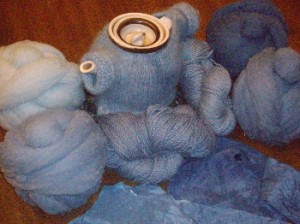“There are many yellows which come from plants. There are many reds which come from plants and insects. But, there is only one blue, indigo” (Maiwa – Indigo a World of Blue DVD)
Unique Structure of Indigo
Indigo, or woad indigo, is a unique dye. The extraction process reflects the different molecular characteristics of indigo, as compared to other natural dyes. As an example, blue jeans fade where the fabric is physically rubbed. Most other natural dyes fade equally in sunlight, and minimally when rubbed.
Indigo does not form a chemical bond with the fabric, as other dyes. Instead it forms a physical bond, bonding molecularly to the fabric when reduced. The reduced state is also necessary because indigo cannot dissolve in water, it is insoluble. When the indigo molecules bond to the fabric and it is re-vatted, the indigo forms layers – like bricks. This makes indigo very impervious to sunlight, but indigo will fade with rubbing.
Reduction and Oxidization
In the reduction vat, the indigo molecule loses an oxygen molecule. This makes it negatively charged. When oxidized, the indigo molecules snatch back new electrons and at the same time bond to the fabric. When the fabric is re-vatted, some indigo is re-reduced but a new layer of molecules is also put down. This layer, when oxidized, then bonds to the previous layer of molecules, making a darker and more permanent colour.
Extraction Whys
In the indigo, or woad indigo extraction, the molecules which form indigo, known as precursors, are soluble and extracted from the plant. During the extraction the soluble precursors bond together to from insoluble indigo. The molecular make up of Indigo is C16, H10, N2, O2, with double bonds on the Hydrogen. These double bonds form single bonds during reduction, and then oxidize back to a double bond with the re-claiming of electrons.
Back To You
Have you ever wondered why indigo was different? Have you ever done an indigo dye vat? Share your story. Leave a comment.

Thank you for this. It piqued my curiosity about the plant sources of this dye so I went exploring and learned all sorts of new things. It’s always a good day when I learn something new! One of many abundances I’m thankful for today.
Thanks Beth.
I am glad you found the article helpful. Learning new things is one of the nicest abundances to have.
Sarah